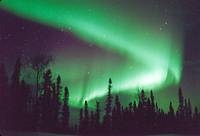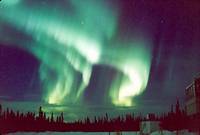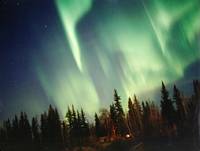The aurora borealis has intrigued people from ancient times, and
still does today. The Eskimos and Indians of North America have
many stories to explain these northern lights.
One story is reported by the explorer Ernest W. Hawkes in his
book, The Labrador Eskimo:
|
The ends of the land and sea are bounded by an
immense abyss,
over which a narrow and dangerous pathway leads
to the
heavenly regions. The sky is a great dome of
hard material
arched over the Earth. There is a hole in it
through which the
spirits pass to the true heavens. Only the
spirits of those who
have died a voluntary or violent death, and the
Raven, have been
over this pathway. The spirits who live there
light torches to
guide the feet of new arrivals. This is the
light of the aurora.
They can be seen there feasting and playing
football with a
walrus skull.
The whistling crackling noise which sometimes
accompanies the
aurora is the voices of these spirits trying to
communicate
with the people of the Earth. They should always
be answered
in a whispering voice. Youths dance to the
aurora. The
heavenly spirits are called selamiut,
"sky-dwellers," those who
live in the sky.
|
Evil Thing
The Point Barrow Eskimos were the only Eskimo group who
considered the aurora an evil thing. In the past they carried
knives to keep it away from them.
Omen of War
The Fox Indians, who lived in Wisconsin, regarded the light as
an omen of war and pestilence. To them the lights were the
ghosts of their slain enemies who, restless for revenge, tried
to rise up again.
Dancing Spirits
The Salteaus Indians of eastern Canada and the Kwakiutl and
Tlingit of Southeastern Alaska interpreted the northern lights
as the dancing of human spirits. The Eskimos who lived on the
lower Yukon River believed that the aurora was the dance of
animal spirits, especially those of deer, seals, salmon and
beluga.

Game of Ball
Most Eskimo groups have a myth of the northern lights as the
spirits of the dead playing ball with a walrus head or skull.
The Eskimos of Nunivak Island had the opposite idea, of walrus
spirits playing with a human skull.
Spirits of Children
The east Greenland Eskimos thought that the northern lights were
the spirits of children who died at birth. The dancing of the
children round and round caused the continually moving streamers
and draperies of the aurora.
Fires in the North
The Makah Indians of Washington State thought the lights were
fires in the Far North, over which a tribe of dwarfs, half the
length of a canoe paddle and so strong they caught whales with
their hands, boiled blubber.
Stew Pots
The Mandan of North Dakota explained the northern lights as
fires over which the great medicine men and warriors of northern
nations simmered their dead enemies in enormous pots. The
Menominee Indians of Wisconsin regarded the lights as torches
used by great, friendly giants in the north, to spear fish at
night.
Creator Reminder
An Algonquin myth tells of when Nanahbozho, creator of the
Earth, had finished his task of the creation, he traveled to the
north, where he remained. He built large fires, of which the
northern lights are the reflections, to remind his people that
he still thinks of them.
Folklore is from Legends of the Northern Lights, by
Dorothy Jean Ray, The ALASKA SPORTSMAN, April 1958, reprinted
in AURORA BOREALIS The Amazing Northern Lights, by
S.I. Akasofu, Alaska Geographic, Volume 6, Number 2, 1979
All of the Aurora images on this page are copyrighted (2003
Jan Curtis) and are intended for non-commercial, educational
uses. Larger versions of these photos and many others can be
viewed from Jan Curtis homepage, Home of the
Northern Lights.
Introducing
the Aurora
- Earth's Great Light Show -
from NASA

 Return to Indigenous Peoples' Literature
Return to Indigenous Peoples' Literature
Compiled by: Glenn
Welker
ghwelker@gmx.com
Copyright
@ 1993-2016
This
site has been accessed 10,000,000 times since February
8, 1996.




![]() Return to Indigenous Peoples' Literature
Return to Indigenous Peoples' Literature